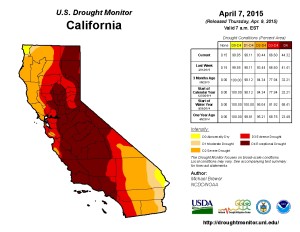In California, residents are experiencing water regulations and challenges amidst a historic statewide drought. This drought, which began in 2011, has continued to prove a challenge for California’s economy, which comes largely from agriculture. According to a CNN report, it is estimated that California grows more than a third of the nation’s vegetables and more than two thirds of the nations fruits and nuts. With the situation becoming so dire, Governor Jerry Brown issued an executive order to reduce water consumption statewide by twenty-five percent..
 Brown issued this sanction while at a press release on top of a snow-barren Phillips Station in the Sierra Nevada mountains. “Today we are standing on dry grass when we should be standing on five feet of snow. This historic drought calls for unprecedented action,” claimed Brown, according to a statement by NBC. Snowpack in mountain ranges across the state provide consistency to the reservoir levels, but also to less obvious places like irrigating farms and ski resorts, both of which rely on snowpack as a source of water for the season. In fact, many ski resorts have been forced to close early this past year, and some are building zip lines, mountain bike trails, and wedding venues to continue the flow of tourists into the area.
Brown issued this sanction while at a press release on top of a snow-barren Phillips Station in the Sierra Nevada mountains. “Today we are standing on dry grass when we should be standing on five feet of snow. This historic drought calls for unprecedented action,” claimed Brown, according to a statement by NBC. Snowpack in mountain ranges across the state provide consistency to the reservoir levels, but also to less obvious places like irrigating farms and ski resorts, both of which rely on snowpack as a source of water for the season. In fact, many ski resorts have been forced to close early this past year, and some are building zip lines, mountain bike trails, and wedding venues to continue the flow of tourists into the area.
This scramble to adapt to dwindling resources is found in creative ways all across the state. Statewide, restaurants are required to only give customers water by request, and hotel chains must ask guests if they are willing to not have their linens laundered each day. In Santa Barbara, city officials are looking into reopening a water desalination plant to quench the city’s shortage, and are paying a hefty price tag, close to $1 billion, to do so.
In Los Angeles, residents are being paid by utilities companies to replace their grass lawns with more drought tolerant alternatives. The city of Palm Springs, where water consumption per capita more than doubles the state average at 201 gallons per day, has begun a campaign to reduce their consumption by as much as fifty percent. The city plans to do this by removing grass medians of the city and instead replacing them with things like cactus and desert bushes. They are also paying their residents to do the same with their own lawns, as well as offering those residents substantial rebates if they choose to install low-flow toilets.
Even with all of these changes however, there will not be nearly as much of a shift in water consumption as even a minor reform by farmers. Currently, farmers consume about eighty percent of all water in the state of California. Many farmers have reported substantial decreases in the number of acres they are able to plot this year, coming in response to the reported twenty percent allocation by the California Dept of Water Resources of the more than 4.2 million acre-feet of water requested.
Despite these reductions in yield, consumers are not expected to see extreme rises in food costs. This is due in part because of food diversity. If, for example, rice production, which requires the rice to be submerged in water to grow, drops in California, rice farmers in the South might shift their production to meet the need. However, this is not to say that the problem is over. With drought covering more than ninety-eight percent of the state, California will continue to adapt to the changes in its environment.
